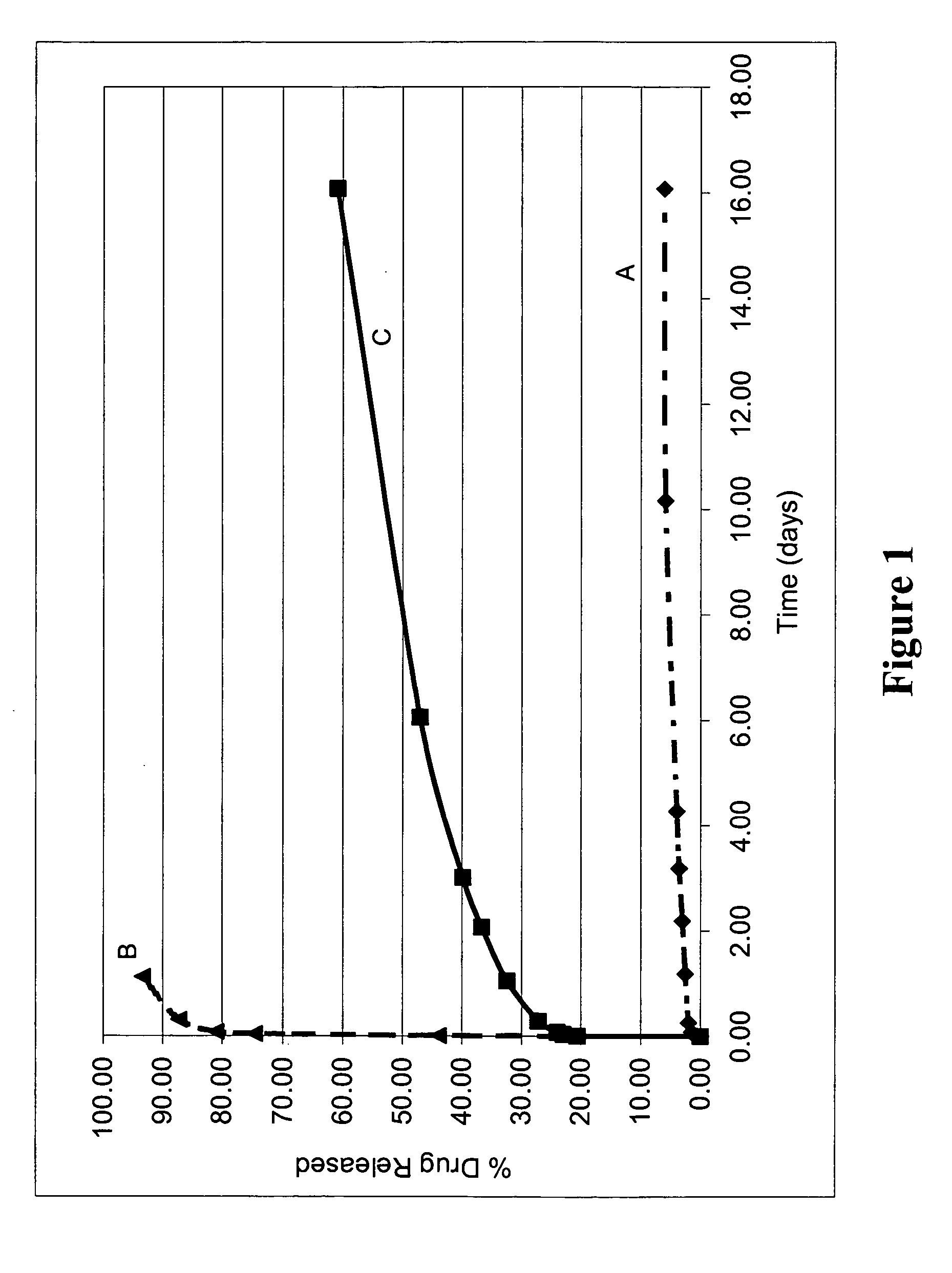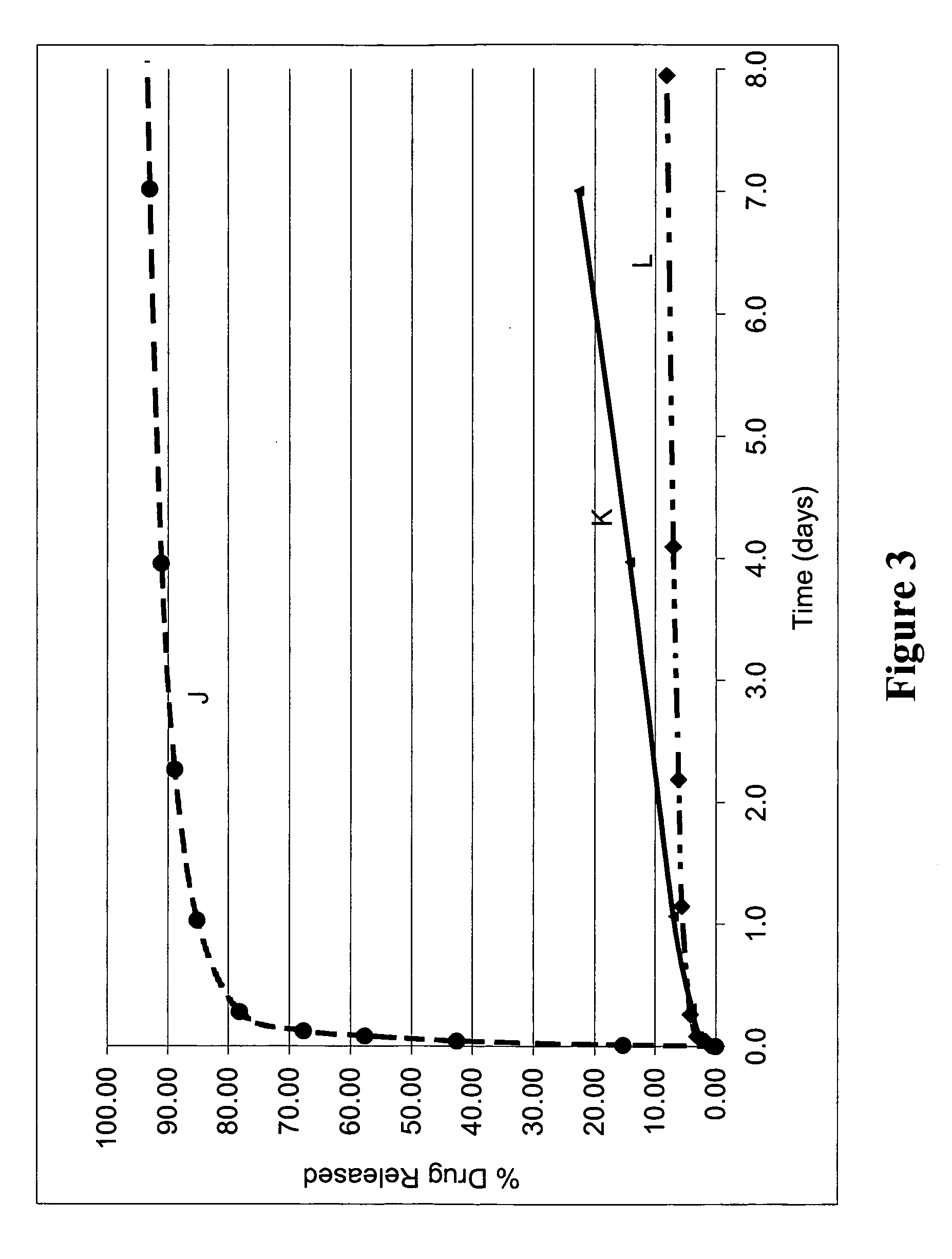Biodegradable coating compositions including multiple layers
a biodegradable and coating technology, applied in the field of medical devices, can solve the problems of adverse reactions to medical devices, increased tissue damage, scar tissue development, restenosis is also a major problem, etc., and achieve linear bioactive agent release rates, avoid toxic levels of bioactive agents, and control the release of bioactive agents over time
- Summary
- Abstract
- Description
- Claims
- Application Information
AI Technical Summary
Benefits of technology
Problems solved by technology
Method used
Image
Examples
example 1
Elution of Bioactive Agent from Representative Multilayer Coatings Including Two Coated Layers
[0328] Various biodegradable coatings were prepared to include a representative small molecular weight bioactive agent, and the resultant elution profiles were observed.
[0329] For baseline comparisons, two groups of stents were provided with a single coated layer containing the bioactive agent. The first group of stents was provided with a single coated layer of PLLA and dexamethasone (Coating A), the coating composition prepared as described above. The second group of stents was provided with a single coated layer of PolyActive™ polymer and dexamethasone (Coating B), the coating composition prepared as described above.
[0330] In addition, a group of stents were provided with a second coated layer composed of PolyActive™ polymer (without addition of a bioactive agent) (Coating C). For these coated layers containing PolyActive™ polymer, the PolyActive™ polymer was dissolved in chloroform t...
example 2
Elution of Bioactive Agent from Representative Multilayer Coatings Including Three Coated Layers and PolyActive™ Polymer Outer Coating
[0336] Stainless steel stents were provided with a coating composed of three coated layers, wherein the first coated layer included a model small molecular weight bioactive agent, dexamethasone. The coatings were evaluated for bioactive agent release as follows.
[0337] A first coated layer composed of PLLA and dexamethasone was prepared and applied to the stents as previously described. A second coated layer composed of PLLA (without bioactive agent) was prepared and applied to the stents as previously described. A third coated layer composed of PolyActive™ polymer (without bioactive agent) was prepared and applied to the stents as previously described. The average weight of the third coated layer for the stents was 130 micrograms. Table 3 lists the coating weights and composition for the first two coated layers.
TABLE 3Coating CharacteristicsFirstS...
example 3
Elution of Bioactive Agent from Representative Multilayer Coatings Including PLLA Outer Layer
[0344] Experiments were conducted to illustrate the effect of multiple coated layers on bioactive agent release profiles.
[0345] Stents were provided with a first coated layer containing either PolyActive™ polymer or PLLA with paclitaxel as a model bioactive agent. These coatings were prepared and applied to the stainless steel stents as described previously. For one group of stents (Stent K), a second coated layer of bioactive-agent free PLLA was applied to adjust bioactive agent release rate. For these coated layers, PLLA was dissolved in tetrahydrofuran to a concentration of 20 milligrams per milliliter, and then applied as a second layer over the existing bioactive agent containing coating by ultrasonic spraying. The stents were then dried in a vacuum oven set at room temperature.
[0346] Table 4 lists the coating compositions and bioactive agent weights. FIG. 3 displays the paclitaxel e...
PUM
| Property | Measurement | Unit |
|---|---|---|
| temperature | aaaaa | aaaaa |
| half-weight degradation time | aaaaa | aaaaa |
| half-weight degradation time | aaaaa | aaaaa |
Abstract
Description
Claims
Application Information
 Login to View More
Login to View More - R&D
- Intellectual Property
- Life Sciences
- Materials
- Tech Scout
- Unparalleled Data Quality
- Higher Quality Content
- 60% Fewer Hallucinations
Browse by: Latest US Patents, China's latest patents, Technical Efficacy Thesaurus, Application Domain, Technology Topic, Popular Technical Reports.
© 2025 PatSnap. All rights reserved.Legal|Privacy policy|Modern Slavery Act Transparency Statement|Sitemap|About US| Contact US: help@patsnap.com



